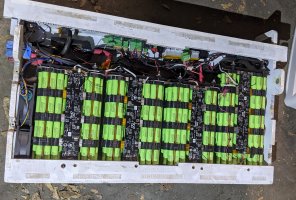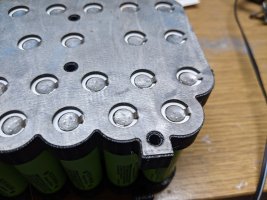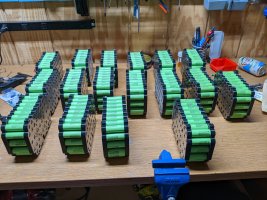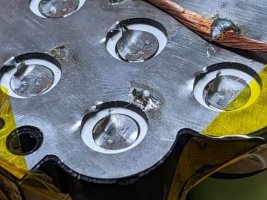Hi all. I wanted to post about a project I'm starting, and it's got a neat bit of personal history to it.
Eight years ago, when I was in college, I helped build a battery pack for our school's entry in the 2013 World Solar Challenge. We designed the pack from scratch, built a custom BMS for it, the works.
Then, when the race was over, the battery sat collecting dust in a shop somewhere. I graduated and move on to other interests. Then I heard they were looking for a home for the battery, and I started learning about the second life battery scene, made an inquiry, and a few days later drove home with 8 kWh of ambition.
Here's how the battery looked when I got it:

The pack is13 17s39p. The original car had two of these wired in series. The BMS is still partially wired in, but to my surprise, none of the cells had been drained after 8 years of storage. Cells are Panasonic NCR18650B with maybe a dozen cycles on them, all at 3.55V except one at 3.45V.
The plan: I'll remove all the electronics (I don't trust anything I designed in college) and all the modules (groups of parallel cells - is module the right term?). I thought of reusing the box but it's too tight and I don't like how the modules are stacked. Wall-mount the modules, add a new BMS, connect to the solar/charge controller I already have, and use it to charge my Leaf.
There are a few decisions I'm still unsure about and would appreciate comments on:
Should I add cell-level fusing? Right now cells are connected with a pretty wide nickle strip (I'll get a pic once I get the modules out). My thought was to cut all the positive strips, let it sit for a while to make sure no cells are self-discharging (probably a redudant test considering everything still has charge), then solder a thin wire between the positive and the rest of the nickle. I don't plan to draw more than 1A per cell and I'd rest easier with the extra protection.
I'm also trying to choose a BMS. I like what I've seen from Batrium but it's just too expensive for me. The diyBMS looks neat but I worry about how much of a time sink it'd be to build and set that up. Daly is nice and cheap but I can't tell if it will do everything I want it to.
Last thing is the output. I don't want to muck with grid connections and regulations right now so I thought I'd use the pack to power my biggest load: My '17 Nissan Leaf. I use around 4-5 kWh each weekday for my commute. I figure I can just go battery->inverter->EVSE->car but I'm curious if anyone's gotten more clever then that.
Eight years ago, when I was in college, I helped build a battery pack for our school's entry in the 2013 World Solar Challenge. We designed the pack from scratch, built a custom BMS for it, the works.
Then, when the race was over, the battery sat collecting dust in a shop somewhere. I graduated and move on to other interests. Then I heard they were looking for a home for the battery, and I started learning about the second life battery scene, made an inquiry, and a few days later drove home with 8 kWh of ambition.
Here's how the battery looked when I got it:

The pack is
The plan: I'll remove all the electronics (I don't trust anything I designed in college) and all the modules (groups of parallel cells - is module the right term?). I thought of reusing the box but it's too tight and I don't like how the modules are stacked. Wall-mount the modules, add a new BMS, connect to the solar/charge controller I already have, and use it to charge my Leaf.
There are a few decisions I'm still unsure about and would appreciate comments on:
Should I add cell-level fusing? Right now cells are connected with a pretty wide nickle strip (I'll get a pic once I get the modules out). My thought was to cut all the positive strips, let it sit for a while to make sure no cells are self-discharging (probably a redudant test considering everything still has charge), then solder a thin wire between the positive and the rest of the nickle. I don't plan to draw more than 1A per cell and I'd rest easier with the extra protection.
I'm also trying to choose a BMS. I like what I've seen from Batrium but it's just too expensive for me. The diyBMS looks neat but I worry about how much of a time sink it'd be to build and set that up. Daly is nice and cheap but I can't tell if it will do everything I want it to.
Last thing is the output. I don't want to muck with grid connections and regulations right now so I thought I'd use the pack to power my biggest load: My '17 Nissan Leaf. I use around 4-5 kWh each weekday for my commute. I figure I can just go battery->inverter->EVSE->car but I'm curious if anyone's gotten more clever then that.
Last edited:








